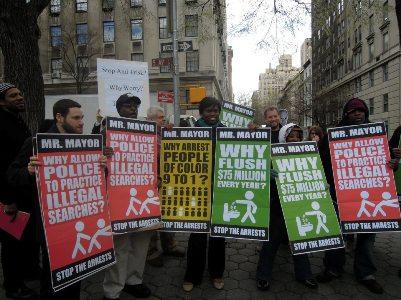
In This Issue: - Feature Story » GO
- Putting Faces on Justice » GO
- Segregation Behind Prison Bars » GO
- Upcoming Events » GO

Search our Clearinghouse of over 450 books, articles, and reports on racial disparity in the criminal justice system.
Upcoming Events
Facing Race
"Define Justice and Make Change"
Chicago, IL, September 23-25, 2010
The Facing Race conference will include discussions of hot-button race issues while offering models for change. It will serve as a focal point for organizations and individuals committed to crafting innovative strategies for changing policy and shaping culture to advance real racial justice.
Symposium on Crime and Justice
"The Past and Future of Empirical Sentencing Research"
Albany, NY, September 23-24, 2010
The symposium is based on the premise that new advances in sentencing research will come in part from engaging with other disciplines that focus on sentencing issues, and engaging with ongoing public policy issues like prison overcrowding and risk assessment. The main topics will be the role of race in sentencing outcomes, discretion and decision making, managing the criminal justice population, and risk assessment in the sentencing process.
Bureau of Justice Statistics and the Justice Research and Statistics Association 2010 National Conference
"Using Statistics and "Research to Improve Justice Policies and Practices"
Portland, Maine, October 28-29, 2010
The program includes more than 20 panel sessions on topics, including, corrections, domestic violence, human trafficking, racial disparity, reentry, research using national incident based reporting system (NIBRS) data, sentencing, substance abuse, tribal crime data, and victimization, as well as plenary discussions on current justice issues. There will also be skill building seminars (October 26th, 27th, and 30th) on cost-benefit analysis, evaluation methods, and evidence-based programs and practices. Contact Us Do you have a contribution or idea for Race & Justice News? Send an email to The Sentencing Project's research analyst, Valerie Wright. | The Sentencing Project
1705 DeSales Street, NW
8th Floor
Washington, D.C. 20036 |
| September 1, 2010 Race & Justice News "The biggest crime in the U.S. criminal justice system is that it is a race-based institution where African-Americans are directly targeted and punished in a much more aggressive way than white people. Saying the U.S. criminal justice system is racist may be politically controversial in some circles. But the facts are overwhelming. No real debate about that."
-- Dr. Nancy Heitzeg, Professor of Sociology and Co-Director of the Interdisciplinary Critical Studies of Race/Ethnicity Program at Saint Catherine University FEATURED STORY RACIAL PROFILING PART OF EVERYDAY LIFE IN BROOKLYN Allegations of racial profiling have become common in many predominantly black neighborhoods across the country. The New York Times recently reviewed police data provided by the New York Police Department, the Center for Constitutional Rights and the New York Civil Liberties Union on police stops and found that the police made nearly 52,000 stops in an eight-block radius of Brownsville, Brooklyn between January 2006 and March 2010. Overall, 88% of individuals stopped were black or Hispanic. Despite the large number of stops only 1% yielded an arrest over a four-year period. Typically, squad cars with flashing lights cruise along the main avenues and officers use their controversial "Stop, Question, and Frisk" tactic on residents. The encounters are so frequent that they amount to nearly one stop per year for the 14,000 residents over the four-year period.
The Times reports that if police think someone is carrying a weapon or entering a building without a key it is common for them to ask for identification and check to see if the individual has any warrants. In many encounters with police, residents were told that they fit the description of a suspect. However, the data show that less than 9% of stops were made based on "fit description." More often than not, the police listed "furtive movement," a vague category that equates to "other" as the grounds for the stop. This stop-and-frisk strategy has come under intense scrutiny and the New York Civil Liberties Union and the Center for Constitutional Rights have filed lawsuits challenging the NYPD's current practices. Click here to read more. PUTTING FACES ON JUSTICE 
VOICES FROM BROOKLYN Watch and listen to the residents from a public housing community in Brownsville, Brooklyn speak for themselves about how they believe they have been unfairly targeted by police stop-and-frisk tactics. One young man states "If you see cops, they automatically search you." Several other residents say they feel "belittled," "violated" and "degraded" as a result of their contact with police. SEGREGATION BEHIND PRISON BARS INMATES STILL HOUSED BY RACE AFTER SUPREME COURT RULING In a 5-3 decision reached in 2005 the U.S. Supreme Court decided that prison officials in California could not rely solely on racial classification when assigning inmate housing. Historically, prison officials in the state have relied on race to separate male inmates. Five years after the ruling, approximately 165,000 inmates in California are still housed by race and critics argue that the state is not responding quickly enough to the ruling. Part of the problem is that the state Department of Corrections and Rehabilitation does not keep a record of integrated cells and therefore does not know how much change has occurred. In addition, only four of California's 30 prisons have implemented guidelines that consider additional factors such as gang affiliation and offense committed in determining housing location.
One prison spokesman, Lt. Anthony Gentile, asserted that "These boundaries are determined by the inmate population." Another spokeswoman, Terry Thornton, emphasizes that there is no deadline for ending segregation by race in prisons and such changes should be implemented slowly. In addition, she points out that, "The deficit-ridden state also has no money for additional training needed for prison staffers to learn the new ways to assign cellmates." Click here to read more. Back to top ^ |





